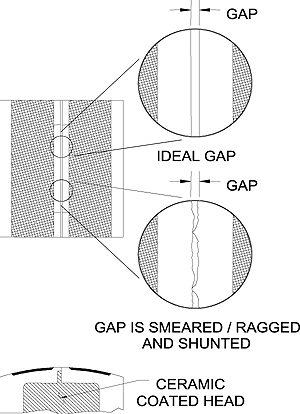
Design Guide 3 - Likely Causes of Inconsistent Dynamic Performance
Magnetic Heads Used in High Traffic Fare Collection Applications
- Gap definition and length varying as the Magnetic head wears.
- Spacing Losses (see Design Guide 2)
- Rapid Wear
Magnetic heads used in high traffic areas such as subway turnstiles, buses and toll roads must operate under the harshest conditions imaginable. From high heat and high humidity to below freezing and low humidity (toll roads), all kinds of dirt (subway), and excessive vibration (buses). In addition, these heads often must read and write on very poor quality media. All of these factors are considered in magnetic heads designed by Brush Industries.
1. Gap Definition and length varying as the Magnetic Head wears.

Soft Core Mu-Metal Magnetic Head
Many times the gap on a standard soft-core head becomes ragged and irregular (smeared / shunted) as the Magnetic Head wears. The soft Mu-Metal core material is smeared or abraded into the gap material by the constant abrasive action of the magnetic media moving under pressure across the top of the Magnetic Head.
As the smearing and shunting of the Gap takes place the dynamic performance changes with the changing Gap Size.

The Gap Size on a hard core ferrite head will experience the opposite effect of a Mu-Metal magnetic head. Instead of the Gap smearing and becoming smaller, the edges of the ferrite material start to erode away and the Gap size becomes larger and losses its size and definition. This phenomenon is a result of the brittle nature of ferrite. The constant impacting of tickets into the magnetic head cause minute particles of the ferrite at the Gap to fracture and break away. This eroding of the Gap is the same as increasing the Gap size and has a corresponding effect on the dynamic performance.

Magnetic Heads manufactured with Supermium® Pole Pieces will not be effected by gap smearing or gap erosion. The Hardness (48/52 RC) and Toughness (not brittle) of Supermium® core material maintains a uniform size, well defined gap throughout the life of the head insuring consistent dynamic performance.
2. Spacing Losses
Spacing loss is a condition that occurs when the magnetic pole pieces at the gap of the magnetic head losses inanimate contact with the magnetic media. The loss of contact with the magnetic media has a direct bearing on the ability of the magnetic head to write, overwrite and on read output. (See below) Spacing losses are most usually caused by dirt build up on the head or uneven wear due to hard/soft material (scalloping). Dirt build up usually occurs at the leading and trailing edges of the contour, causing the magnetic media to loss contact with the gap.
Note: Read signal decreases exponentially with the distance between the magnetic head gap and the magnetic media.

3. Rapid Wear
The PFD (pole face depth) is the primary factor controlling the life of a magnetic head. A typical new Brush magnetic head would have a PFD of .015/.017. As the magnetic head wears the PFD decreases, resulting in increasing output and decreasing saturation current. The faster the magnetic head wears the more dramatic the dynamic changes seem. Soft core Mu-Mtetal heads can experience very rapid wear, such that a new head can reach end of life in as few as 50,000 transactions. The dynamic changes occurring in this type of head would be very noticeable. supermium® ceramic coated heads can realize as many as 11 million + transactions before realizing end of life, dynamic or performance changes seem very subtle as they occur over and extended period of time.





